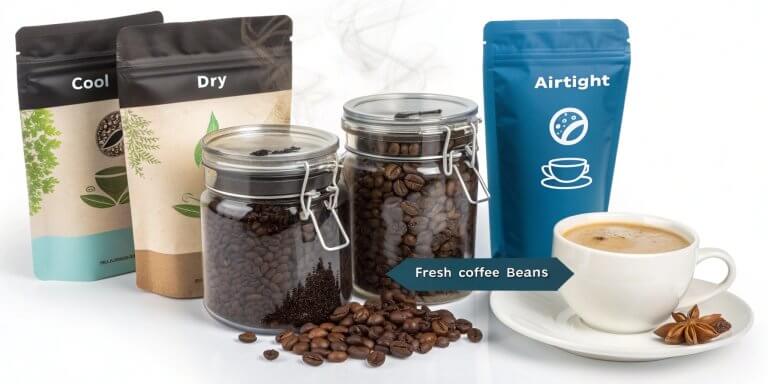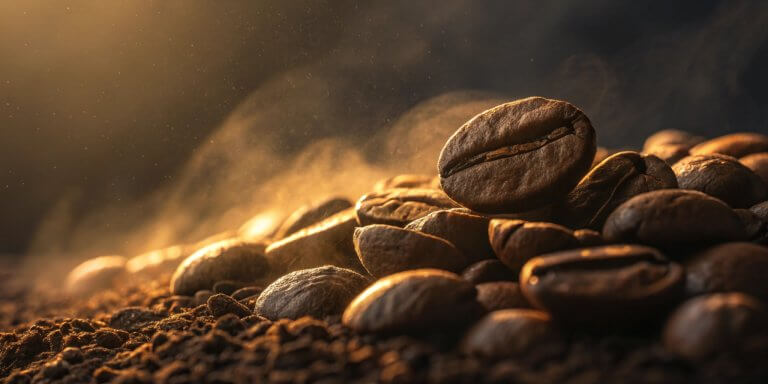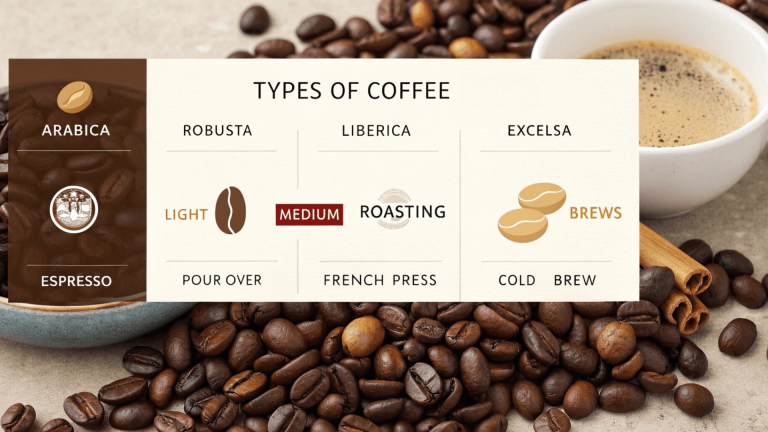
Robusta coffee beans contain 2.2-2.7% caffeine by weight (about 10-12mg per bean), while Arabica beans have 1.2-1.5% caffeine (about 6mg per bean). This means Robusta packs nearly double the caffeine punch of Arabica beans.
Coffee lovers around the world start their day with this magical brew. But have you ever wondered exactly how much caffeine is hiding in those little beans? The answer might surprise you. Not all coffee beans are created equal when it comes to their energy-boosting power.
This guide breaks down everything you need to know about caffeine in the two main types of coffee beans. You’ll discover why your morning cup might pack more punch than you think.
Understanding Coffee Bean Caffeine
Caffeine is the world’s most popular drug. Yes, it’s technically a drug – but a legal and mostly harmless one. Every day, billions of people rely on this natural stimulant to feel alert and focused.
Coffee beans naturally produce caffeine as their defense system. It’s like nature’s own pest control. The caffeine helps protect the coffee plant from bugs and other threats that might want to eat it.
Two main species dominate the coffee world:
- Arabica (makes up about 60-70% of global coffee)
- Robusta (makes up about 30-40% of global coffee)
These two types have very different caffeine levels. Understanding this difference can help you choose the proper coffee for your needs.
The Science Behind Caffeine in Coffee Beans
How Nature Created Coffee’s Natural Stimulant
Think of caffeine as the coffee plant’s bodyguard. Plants that grow in harsh conditions need more protection. That’s why Robusta plants, which grow at lower elevations with more pests, evolved to produce more caffeine.
Arabica plants grow high up in the mountains, where there are fewer bugs and threats. They don’t need as much caffeine protection. This natural difference explains why your cup of coffee can vary so much in strength.
The caffeine molecule is incredibly stable. It doesn’t break down easily during processing or roasting. This means the caffeine content you see in green (raw) beans stays the same all the way to your cup.
Where Caffeine Lives in Coffee Plants
Caffeine doesn’t just hang out randomly in the coffee plant. It concentrates on specific areas:
- Highest levels: In the coffee beans themselves
- Medium levels: In the leaves and stems
- Lower levels: In the coffee cherry fruit that surrounds the bean
The timing of harvest also matters. Coffee beans that are picked at peak ripeness tend to have more consistent caffeine levels.
Robusta vs Arabica Caffeine Content

Infographic comparing caffeine content per individual coffee bean
The Numbers That Matter
Let’s get specific about how much caffeine these beans actually contain:
Arabica Coffee Beans:
- By weight: 1.2-1.5% caffeine
- Per single bean: About 6 milligrams
- Per gram of beans: 8-12 milligrams
- Per 8-ounce cup: 80-100 milligrams
Robusta Coffee Beans:
- By weight: 2.2-2.7% caffeine
- Per single bean: About 10-12 milligrams
- Per gram of beans: 18-22 milligrams
- Per 8-ounce cup: 200-265 milligrams
This means if you brew a cup of pure Robusta coffee, you’re getting almost twice as much caffeine as Arabica. That’s a significant difference that can really affect how you feel.
Why This Difference Exists
The caffeine gap between these beans comes down to survival. Robusta plants face more challenging growing conditions:
- Lower altitudes (sea level to 2,000 feet)
- Warmer temperatures
- More insects and pests
- Less rainfall
Arabica plants live the good life:
- Higher altitudes (2,000-6,000 feet)
- Cooler temperatures
- Fewer natural threats
- More consistent rainfall
Taste Impact of Caffeine Levels
Higher caffeine doesn’t just mean more energy. It also affects flavor:
- Robusta: More bitter, harsh, sometimes described as burnt rubber
- Arabica: Smoother, sweeter, more complex flavors
This is why most specialty coffee shops use 100% Arabica beans. The lower caffeine creates a more pleasant drinking experience.
How Your Brewing Method Affects Caffeine Content

Infographic showing caffeine content by different brewing methods
The way you make your coffee has a significant impact on how much caffeine ends up in your cup. Even if you use the same beans, different brewing methods extract different amounts of caffeine.
Extraction by Brewing Method
Espresso:
- 29-100mg per 1-ounce shot
- High-pressure extraction
- Short contact time (25-30 seconds)
- Fine grind increases surface area
French Press:
- 80-135mg per 8-ounce cup
- Long steeping time (4 minutes)
- Coarse grind
- Full immersion brewing
Drip Coffee:
- 95-200mg per 8-ounce cup
- Medium grind
- Hot water passes through the coffee once
- Most common home brewing method
Cold Brew:
- 150-300mg per 8-ounce serving
- Longest extraction time (12-24 hours)
- Cold water extraction
- Highest caffeine content per serving
What Affects Caffeine Extraction
Several factors control how much caffeine gets pulled from your beans:
Grind Size:
- Fine grind: More surface area = more caffeine extracted
- Coarse grind: Less surface area = less caffeine extracted
Water Temperature:
- 195-205°F: Optimal extraction temperature
- Higher temperatures: Extract more caffeine
- Cold water: Extracts less caffeine (but longer time compensates)
Contact Time:
- Longer contact: More caffeine extraction
- Shorter contact: Less caffeine extraction
- Sweet spot: Depends on grind size and temperature
Coffee-to-Water Ratio:
- More coffee: Higher caffeine concentration
- Less coffee: Lower caffeine concentration
- Standard ratio: 1:15 to 1:17 (coffee to water)
Does Roasting Really Change Caffeine Levels?

Infographic showing how roasting levels affect caffeine content
Here’s one of the biggest coffee myths: “Dark roast has more caffeine because it tastes stronger.” This is entirely wrong. Let’s set the record straight with actual science.
The Real Truth About Roasting
Scientific studies using precise laboratory equipment (HPLC analysis) show that roasting level has almost no effect on caffeine content:
Arabica Roasting Results:
- Light roast: 0.0779 mg/g caffeine
- Medium roast: 0.0893 mg/g caffeine
- Dark roast: 0.0909 mg/g caffeine
Robusta Roasting Results:
- Light roast: 0.1399 mg/g caffeine
- Medium roast: 0.1432 mg/g caffeine
- Dark roast: 0.2115 mg/g caffeine
The differences are tiny. Certainly not enough to make a real impact on your caffeine intake.
What Actually Happens During Roasting
When coffee beans get roasted, several things happen:
- Water evaporates (beans lose 15-25% of their weight)
- Oils develop (create flavor compounds)
- Sugars caramelize (adds sweetness and color)
- Caffeine stays stable (doesn’t break down until 600°F+)
Since most coffee roasting happens between 350-450°F, the caffeine molecules remain intact. You’d need to heat beans to over 600°F to destroy caffeine.
Why Dark Roast Tastes Stronger
If dark roast doesn’t have more caffeine, why does it taste so strong? The answer is simple: bitter compounds.
During roasting, other compounds develop that taste bitter and harsh. These aren’t caffeine, but they trick your taste buds into thinking the coffee is stronger. Meanwhile, the actual caffeine content stays about the same.
How Processing Affects Caffeine

Infographic comparing different coffee processing methods and caffeine retention
Before coffee beans reach your local roaster, they go through various processing methods. These can affect caffeine levels and definitely impact flavor.
Processing Method Breakdown
Natural (Dry) Processing:
- Coffee cherries dry in the sun with beans inside
- Caffeine impact: Slightly higher retention
- Flavor impact: Fruitier, sweeter taste
- Time required: 2-4 weeks
Washed (Wet) Processing:
- Fruit removed immediately, beans washed clean
- Caffeine impact: Standard retention levels
- Flavor impact: Cleaner, brighter taste
- Time required: 1-2 weeks
Honey Processing:
- Partial fruit removal, sticky layer remains
- Caffeine impact: Between natural and washed
- Flavor impact: Balanced sweetness and brightness
- Time required: 2-3 weeks
The Decaffeination Process
Sometimes people want the taste of coffee without the caffeine. Several methods remove caffeine from beans:
Swiss Water Process:
- Uses only water (no chemicals)
- Removes 99.9% of caffeine
- Maintains most flavor compounds
- Takes 8-10 hours
Chemical Methods:
- Uses methylene chloride or ethyl acetate
- Removes 97-99% of caffeine
- Faster than water method
- Some flavor loss
CO2 Method:
- Uses pressurized carbon dioxide
- Removes 97% of caffeine
- Preserves flavor well
- Most expensive method
Even “decaffeinated” coffee isn’t 100% caffeine-free. It still contains 2-15mg per cup. That’s about the same as a piece of chocolate.
Caffeine Content and Your Health

Infographic showing daily caffeine intake recommendations and health guidelines
Understanding how much caffeine you’re consuming isn’t just about staying awake. It’s about staying healthy and avoiding unwanted side effects.
Daily Caffeine Guidelines
Health experts have studied caffeine extensively. Here are the official recommendations:
Healthy Adults:
- Maximum daily limit: 400mg
- Equivalent to: 4-5 cups of Arabica coffee
- Or: 1.5-2 cups of Robusta coffee
Pregnant Women:
- Maximum daily limit: 200mg
- Equivalent to: 2 cups of Arabica coffee
- Reason: Protects the developing baby
Teenagers (14-17 years):
- Maximum daily limit: 100mg
- Equivalent to: 1 cup of coffee
- Growing brains need protection
Children:
- Recommended limit: None to very little
- Alternative: Decaf or hot chocolate
- Caffeine affects development
Individual Differences in Caffeine Processing
Not everyone processes caffeine the same way. Your genes, age, and health status all play a role:
Fast Metabolizers:
- Process caffeine quickly (2-3 hours)
- Can drink coffee later in the day
- Less likely to get jittery
- About 50% of people
Slow Metabolizers:
- Take 6-8 hours to process caffeine
- Should avoid afternoon coffee
- More sensitive to effects
- About 50% of people
Factors That Affect Metabolism:
- Age: Slower processing as you get older
- Pregnancy: Much slower processing
- Medications: Some drugs slow caffeine breakdown
- Liver health: Liver processes caffeine
Benefits vs Risks
Potential Benefits:
- Improved alertness and focus
- Better physical performance
- May reduce the risk of certain diseases
- Can boost metabolism temporarily
Potential Risks:
- Anxiety and jitteriness
- Disrupted sleep patterns
- Increased heart rate
- Digestive issues
- Dependency and withdrawal
The key is finding your personal sweet spot. Pay attention to how caffeine affects you and adjust accordingly.
Caffeine Content Variations
Specialty coffee has exploded in popularity. Understanding how different origins and processing methods affect caffeine can help you make better choices.
Regional Caffeine Variations
Coffee from different regions can have varying caffeine levels, even within the same species:
High Caffeine Arabica Regions:
- Ethiopian varieties: Often higher than average
- Brazilian varieties: Moderate to high levels
- Central American varieties: Consistent moderate levels
Processing Impact by Region:
- Ethiopian natural process: Higher caffeine retention
- Colombian washed process: Standard caffeine levels
- Hawaiian wet processing: Slightly lower caffeine
Commercial Blends and Caffeine Management
Coffee companies carefully balance their blends for consistent caffeine levels:
Espresso Blends:
- Often includes some Robusta (10-30%)
- Boosts caffeine content
- Improves crema formation
- Reduces cost
Breakfast Blends:
- Usually 100% Arabica
- Moderate caffeine levels
- Designed for daily drinking
- Smooth, approachable taste
Dark Roast Blends:
- May use higher-caffeine origins
- Compensates for perceived strength loss
- Often includes some Robusta
- Bold flavor profiles
The Science of Caffeine Analysis in Coffee
Ever wonder how coffee companies know precisely how much caffeine is in their beans? Modern science has precise methods for measuring these levels.
Laboratory Testing Methods
HPLC (High-Performance Liquid Chromatography):
- Gold standard for caffeine analysis
- Accurate to within 0.001mg
- Used in research and quality control
- Takes 2-3 hours per sample
UV-Vis Spectrophotometry:
- Faster alternative method
- Less expensive equipment
- Good for routine testing
- About 95% accuracy
Sample Preparation:
- Beans ground into a fine powder
- Caffeine extracted with solvents
- Solution filtered and purified
- Injected into the analysis equipment
Home Testing Options
While you can’t match laboratory precision at home, some options exist:
Consumer Test Kits:
- Basic color-change indicators
- Rough estimates only
- Good for comparing coffees
- Costs about $10-20
Mobile Apps:
- Track your caffeine intake
- Estimate based on coffee type
- Monitor daily totals
- Free to download
Visual Indicators:
- Robusta beans are rounder
- Arabica beans are more oval
- Nota foolproof method
- Good starting point
Making Informed Choices About Your Coffee’s Caffeine Content
Now that you understand the science, let’s talk practical applications. How can you use this knowledge to improve your coffee experience?
Selecting Coffee Based on Your Caffeine Needs
If You Want Higher Caffeine:
- Choose Robusta or Robusta blends
- Look for light to medium roasts
- Try cold brew preparation
- Use finer grinds
If You Prefer Moderate Caffeine:
- Stick with 100% Arabica
- Any roast level works
- Standard brewing methods
- Normal grind sizes
If You Want Lower Caffeine:
- Choose Arabica varieties
- Try larger grind sizes
- Shorter extraction times
- Consider half-caff blends
Timing Your Caffeine Intake
Morning (6-9 AM):
- Higher caffeine is usually fine
- Most people metabolize well
- Won’t interfere with sleep
- Peak alertness benefits
Afternoon (12-3 PM):
- Moderate caffeine recommended
- Consider your metabolism speed
- Avoid if you’re sensitive
- May affect evening sleep
Evening (After 6 PM):
- Low or no caffeine recommended
- Can disrupt sleep quality
- Decaf alternatives available
- Individual tolerance varies
Storage Impact on Caffeine
How you store your coffee beans affects their caffeine content over time:
Optimal Storage Conditions:
- Temperature: Room temperature (65-70°F)
- Humidity: Low (under 50%)
- Light: Dark storage area
- Air: Airtight containers
What Happens Over Time:
- Caffeine levels remain stable for months
- Flavor compounds break down faster
- Fresh grinding helps preservation
- Whole beans last longer than ground beans
Future Trends in Coffee Caffeine Research
The coffee industry continues to evolve. New research and consumer demands are driving interesting developments in caffeine science.
Genetic Research and Development
Scientists are working on exciting new developments:
Low-Caffeine Arabica Varieties:
- Naturally occurring mutations
- Traditional breeding programs
- 30-50% less caffeine than normal
- Maintains a good flavor profile
High-Caffeine Arabica Varieties:
- Selective breeding for higher caffeine
- Could rival Robusta levels
- Better taste than the current Robusta
- Several years away from the market
Precision Agriculture:
- Using technology to optimize caffeine
- Monitoring plant stress levels
- Adjusting growing conditions
- More consistent caffeine levels
Consumer Trends Driving Change
Caffeine Transparency:
- More detailed labeling requests
- QR codes linking to lab results
- Batch-specific information
- Real-time caffeine tracking
Functional Coffee Products:
- Enhanced caffeine formulations
- Slow-release caffeine coatings
- Added vitamins and minerals
- Targeted health benefits
Sustainable Caffeine:
- Environmentally friendly processing
- Lower water usage methods
- Reduced chemical processing
- Carbon footprint considerations
Your Caffeine-Informed Coffee Journey
You now have the complete picture of caffeine in coffee beans. Let’s wrap up with the key takeaways that will help you make better coffee choices.
Essential Points to Remember
The Basics:
- Robusta has about double the caffeine of Arabica
- Individual beans contain 6-12mg of caffeine
- Brewing method matters more than roast level
- Your genetics affect how you process caffeine
Practical Applications:
- Read labels to understand what you’re drinking
- Experiment with different origins and processing methods
- Pay attention to how caffeine affects your body
- Adjust your choices based on timing and tolerance
Action Steps for Better Coffee Choices
- Identify your caffeine goals (high energy vs. smooth drinking)
- Try different bean types (pure Arabica vs. Robusta blends)
- Experiment with brewing methods (find your perfect strength)
- Monitor your daily intake (stay within healthy limits)
- Adjust timing (avoid late-day caffeine if it affects sleep)
Final Recommendations
The perfect cup of coffee balances caffeine content with flavor, timing, and your individual tolerance. There’s no one-size-fits-all answer. Use this guide as your starting point, but let your taste buds and how you feel be the final judge.
Whether you’re reaching for a smooth Arabica or a bold Robusta blend, you now understand precisely what you’re getting. That knowledge puts you in control of your coffee experience.
Remember: good coffee is about more than just caffeine. It’s about the ritual, the flavor, the moment of pause in your day. Choose beans that support both your energy needs and your enjoyment. Your morning cup should fuel your body and feed your soul.
The world of coffee is vast and varied. Armed with this caffeine knowledge, you’re ready to explore it with confidence. Happy brewing!

